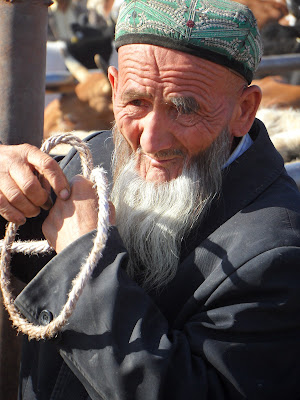Two days before my health decided it needed some time away from me, I asked myself one of those silly questions that have a way of turning against you. Suppose something had to go wrong with either your bike or your body, which would you choose? Easy, I told my imaginary interlocutor. My body, of course. Correct me if I'm wrong, but doesn't the body have this astonishing ability to cure whatever ails it? Don't go expecting it to deal with anything as cataclysmic as a brain hemorrhage, but the common flu or a nasty gash in the head are no match for the magic powers of your body. Just give it a couple of days and you'll be as good as new.
Now try that with a bicycle. 'Flat tire? Oh, let me just put it against the wall, it'll sort itself out.' If anything, that tire will be only flatter after a day or two. In fact, for its well-being my bicycle is wholly dependent on me, a clueless quack who can hardly tell his bottom bracket from his crankset. Just imagine what my poor bike must have gone through when I tried to fix my very first puncture. Having turned the patient upside down, I actually started taking snapshots of the rear wheel because I wasn't sure whether after removing it I'd be able to figure out how to put it back again. I guess it's like being wheeled into the operating room only to hear the surgeon say, just before the anaesthetics kick in: 'Don't worry, sir. We know how to cut you open, but we're still consulting the textbooks on the sewing-up part.' Not very reassuring.
Now, it's true that I've progressed since those early days. It takes me less than thirty minutes to turn a fully-loaded bicycle with a flat tire into a fully-loaded bicycle that's good to go. And, having reversed the sprocket on my Rohloff hub, I even managed to realign the chain tensioner. But some things never change. Strange sounds emanating from unidentified parts of the bike still give me palpitations. And when I'm unable to come up with an immediate solution to a technical issue, part of my mind is already working on an exit strategy: get bike on bus, book flight, go home, forget about the whole thing.
By contrast, I hardly ever worry about that other machine: my body. It's there, it always does what it's supposed to do and it never gives me trouble—apart from the occasional bout of traveller's diarrhoea and, quite curiously, a different skin rash for each country I'm in. Another plus is that it's low on maintenance. Just stuff it with calories, give it the odd scrub and make sure it's in a horizontal position at the end of the day. And—very important to those weight-conscious round-the-world cyclists—there's no need to carry any spare parts.
And then, as I rode into Korla, that trustworthy machine came to a sputtering halt. Rather than one or two parts, it felt as though my entire body needed replacing. There was a dull throb in my head, my neck and shoulders were locked in a painful clasp, my legs were filled with porridge and I was feeling low on sugar, salts and, above all, morale. It had been a long and hot day through the desert, though no longer or hotter than any other day. Still, caught in Korla's afternoon rush hour, looking for a place to stay, I found myself wondering if this is what heatstroke feels like.
A miracle of the human body I haven't mentioned is that it is capable of pushing back its own collapse. Mine got me to a hotel, where it managed to drag thirty kilos worth of luggage up six flights of stairs. Then, having closed the door behind itself, its defences went down. Fever jumped at it from a dark corner, and, just before I slipped into a twelve-hour nightmare marathon, news reached me that my bowels had decided to join the revolution.
And here I am, dealing with the aftereffects not of heatstroke, as it turns out, but good old dysentery. Which is not as dire as it sounds. Every hour or so my bowels perform some kind of Chinese contortion act, which is a sure sign for me to potter off to the shared toilets down the hall to turn one of the cubicles there into (quite literally) a bloody mess. But I'm not complaining. At least the bike is fine.
Now try that with a bicycle. 'Flat tire? Oh, let me just put it against the wall, it'll sort itself out.' If anything, that tire will be only flatter after a day or two. In fact, for its well-being my bicycle is wholly dependent on me, a clueless quack who can hardly tell his bottom bracket from his crankset. Just imagine what my poor bike must have gone through when I tried to fix my very first puncture. Having turned the patient upside down, I actually started taking snapshots of the rear wheel because I wasn't sure whether after removing it I'd be able to figure out how to put it back again. I guess it's like being wheeled into the operating room only to hear the surgeon say, just before the anaesthetics kick in: 'Don't worry, sir. We know how to cut you open, but we're still consulting the textbooks on the sewing-up part.' Not very reassuring.
Now, it's true that I've progressed since those early days. It takes me less than thirty minutes to turn a fully-loaded bicycle with a flat tire into a fully-loaded bicycle that's good to go. And, having reversed the sprocket on my Rohloff hub, I even managed to realign the chain tensioner. But some things never change. Strange sounds emanating from unidentified parts of the bike still give me palpitations. And when I'm unable to come up with an immediate solution to a technical issue, part of my mind is already working on an exit strategy: get bike on bus, book flight, go home, forget about the whole thing.
By contrast, I hardly ever worry about that other machine: my body. It's there, it always does what it's supposed to do and it never gives me trouble—apart from the occasional bout of traveller's diarrhoea and, quite curiously, a different skin rash for each country I'm in. Another plus is that it's low on maintenance. Just stuff it with calories, give it the odd scrub and make sure it's in a horizontal position at the end of the day. And—very important to those weight-conscious round-the-world cyclists—there's no need to carry any spare parts.
And then, as I rode into Korla, that trustworthy machine came to a sputtering halt. Rather than one or two parts, it felt as though my entire body needed replacing. There was a dull throb in my head, my neck and shoulders were locked in a painful clasp, my legs were filled with porridge and I was feeling low on sugar, salts and, above all, morale. It had been a long and hot day through the desert, though no longer or hotter than any other day. Still, caught in Korla's afternoon rush hour, looking for a place to stay, I found myself wondering if this is what heatstroke feels like.
A miracle of the human body I haven't mentioned is that it is capable of pushing back its own collapse. Mine got me to a hotel, where it managed to drag thirty kilos worth of luggage up six flights of stairs. Then, having closed the door behind itself, its defences went down. Fever jumped at it from a dark corner, and, just before I slipped into a twelve-hour nightmare marathon, news reached me that my bowels had decided to join the revolution.
And here I am, dealing with the aftereffects not of heatstroke, as it turns out, but good old dysentery. Which is not as dire as it sounds. Every hour or so my bowels perform some kind of Chinese contortion act, which is a sure sign for me to potter off to the shared toilets down the hall to turn one of the cubicles there into (quite literally) a bloody mess. But I'm not complaining. At least the bike is fine.















